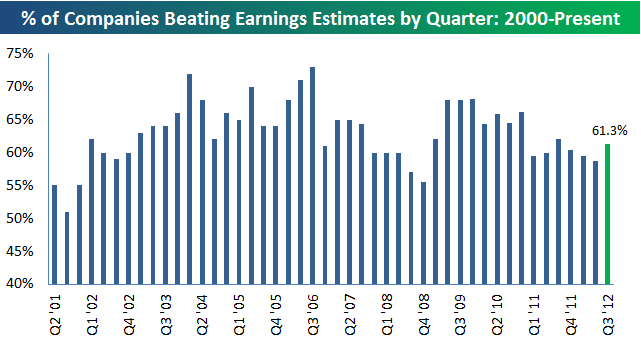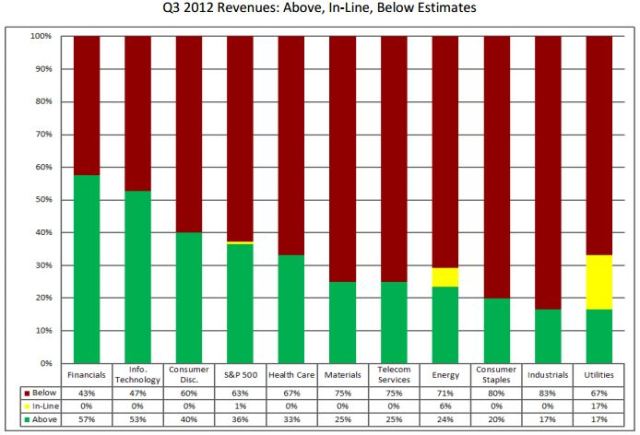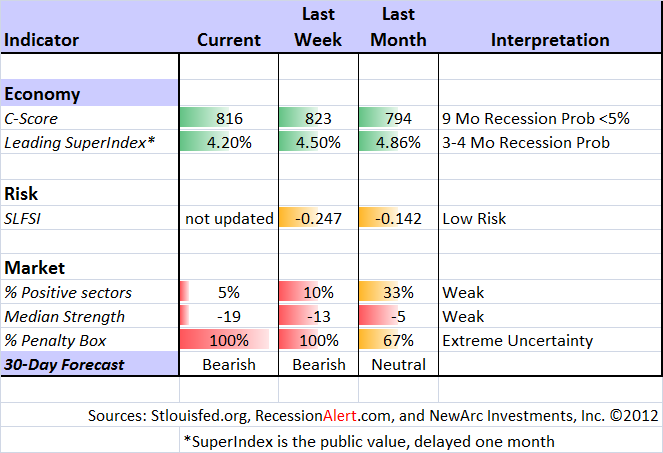Our decisions are always important, but this week could be special. I am giving it extra attention and extra work. I recommend that others do the same. It is not enough to passively watch the news. It means preparing for events! If you do not already have a solid position, you should be poised to react.
For several weeks there has been a sense of an impending inflection point. It is apparent in the technical analysis, with many indicators at key levels. It is obvious in sentiment. And it is obvious in the fundamental issues -- most significantly the fiscal cliff.
The political season has created deferred decisions. This has caused business leaders to defer risk. The cautious outlook from nearly every company reflects these concerns. Why not? Any executive who did not give some lip service to the litany of worries would seem pretty stupid.
Should we take this information at face value?
I'll offer my own take on these complex themes in the conclusion, but first let us do our regular review of last week's news.
Background on "Weighing the Week Ahead"
There are many good lists of upcoming events. One source I especially like is the weekly post from the WSJ's Market Beat blog. There is a nice combination of data, speeches, and earnings reports.
In contrast, I highlight a smaller group of events. My theme is an expert guess about what we will be watching on TV and reading in the mainstream media. It is a focus on what I think is important for my trading and client portfolios.
This is unlike my other articles, where I develop a focused, logical argument with supporting data on a single theme. Here I am simply sharing my conclusions. Sometimes these are topics that I have already written about, and others are on my agenda. I am putting the news in context.
Readers often disagree with my conclusions. Do not be bashful. Join in and comment about what we should expect in the days ahead. This weekly piece emphasizes my opinions about what is really important and how to put the news in context. I have had great success with my approach, but feel free to disagree. That is what makes a market!
Last Week's Data
Each week I break down events into good and bad. Often there is "ugly" and on rare occasion something really good. My working definition of "good" has two components:
- The news is market-friendly. Our personal policy preferences are not relevant for this test. And especially -- no politics.
- It is better than expectations.
The economic news last week was mostly positive. Perhaps it is partly the political season, but there was a little bit of "yes, but" connected to each report.
- Earnings. The earnings "beat rate" is improving as the season progresses. This is an improvement over the recent pattern, and on a pace to better than last three quarters. (But we know expectations were lowered). Bespoke has the story and a great chart.

- The Chinese economy, as measured by the "official PMI" is improving. Kate Mackenzie at FT Alphaville explains that it is really a mixed picture.
- Consumer confidence from the Conference Board is stronger. At face value, this means a reflection of better current conditions and employment. Doug Short has the "yes, but" in his thoughtful post and great chart.

- Payroll employment grew significantly. The "yes, but" is that the overall rate of growth is still disappointing. Calculated Risk has a measured and thoughtful assessment, with plenty of charts. Derek Thompson suggests that the report is better than the headline, since the revisions imply a gain of 255,000 net jobs gained. The pace of gains in the last three months is much better, as you can see from his chart:

- ISM manufacturing was in growth mode and better than expected. It is consistent with economic growth of 3.1% based on ISM research. Steven Hansen at GEI has a thoughtful look at the index and the various components -- well worth reading.
The actual data last week was pretty good, but the stock result was bad.This happens, and it can be meaningful. Let us take a closer look.
- The revenue "beat rate" remains terrible. This chart from Derek Thompson at The Atlantic tells the story by sector:

- The European economy weakens further, as measured by the PMI reports (via FT Alphaville).
- Employment disappointments included no improvement in hours worked (which trades off freely with new jobs at a rate of 330K jobs per hour or so), in hourly wages, or in long-term unemployment. These are all significant elements of the complex employment story.
- Light vehicle sales, while up from last year were down from last month. (Via Calculated Risk).
- Sandy costs. These are now in the $50B range and mounting. Various pundits are speculating (in both directions) about the impact on GDP and economic growth. It is far too soon for this kind of discussion. It is a negative on all fronts.
The US electoral process. It has worked for centuries, but it seems to be broken. The campaigns are now paying about $1000 per head to reach the undecided voters in a few states. The voters sought are the least educated and least informed. They claim to hate negative advertising. In actuality, research shows that the negative ads swing them. If you are a voter in my state (Illinois), your presidential vote does not matter. Will this discourage people from participating? Other races are still important.
The Indicator Snapshot
It is important to keep the current news in perspective. My weekly snapshot includes the most important summary indicators:
- The St. Louis Financial Stress Index.
- The key measures from our "Felix" ETF model.
- An updated analysis of recession probability.
The SLFSI reports with a one-week lag. This means that the reported values do not include last week's market action. The SLFSI has moved a lot lower, and is now out of the trigger range of my pre-determined risk alarm. This is an excellent tool for managing risk objectively, and it has suggested the need for more caution. Before implementing this indicator our team did extensive research, discovering a "warning range" that deserves respect. We identified a reading of 1.1 or higher as a place to consider reducing positions.
The SLFSI is not a market-timing tool, since it does not attempt to predict how people will interpret events. It uses data, mostly from credit markets, to reach an objective risk assessment. The biggest profits come from going all-in when risk is high on this indicator, but so do the biggest losses.
The C-Score is a weekly interpretation of the best recession indicator I found, Bob Dieli's "aggregate spread."
Bob and I recently did some videos explaining the recession history. I am working on a post that will show how to use this method. Bob and I met this week, planning an update soon after the election. As I have written for many months, there is no imminent recession concern. I recently showed the significance of by explaining the relationship to the business cycle.
RecessionAlert uses a variety of different methods, including the ECRI, in developing a Super Index. They also offer a free sample report. Anyone following them over the last year would have had useful and profitable guidance on the economy.
Doug Short has excellent continuing coverage of the ECRI recession prediction, now over a year old. Doug updates all of the official indicators used by the NBER and also has a helpful list of articles about recession forecasting. The most recent news from the ECRI states that they are "Assessing the Current Optimism." This is apparently available only to paid subscribers, the ones who had early access to the 2011 forecast.
Readers might also want to review my new Recession Resource Page, which explains many of the concepts people get wrong. 
Our "Felix" model is the basis for our "official" vote in the weekly Ticker Sense Blogger Sentiment Poll. We have a long public record for these positions. This week we shifted to a bearish position, but it was a pretty close call. These are one-month forecasts for the poll, but Felix has a three-week horizon. Felix's ratings have continued to drift lower. The penalty box percentage measures our confidence in the forecast. That indicator has moved to the top of the range, indicating little confidence in the current bearish rating. It has been a close call over the last few weeks.
[For more on the penalty box see this article. For more on the system ratings, you can write to etf at newarc dot com for our free report package or to be added to the (free) weekly ETF email list. You can also write personally to me with questions or comments, and I'll do my best to answer.]
The Week Ahead
This week brings very little economic data.
The "A List" includes the following:
- The election (T). For investors, it is not merely about the Presidential election, but the shape of Congress.
- Initial jobless claims (Th). Employment will continue as the focal point in evaluating the economy, and this is the most responsive indicator.
The "B" List" includes these entries:
- Michigan Sentiment (F). A good read on employment and current conditions.
- ISM services index (M). The service sector has become more important than manufacturing. This series does not have the long history of the ISM, but is gaining more attention.
- Trade balance (Th). Important for the GDP and overall economic health.
There will also be many more earnings reports from a wider variety of sectors. We will probably also see (after a refreshing interlude) some Europe stories.
Nothing will match the election analysis, with investor implications for the fiscal cliff, taxes, economic growth, and specific stocks.
Trading Time Frame
Felix has shifted to a bearish posture. It has been a close call for several weeks, but it is now turning more negative. Felix has done very well this year, becoming more aggressive in a timely fashion, near the start of the summer rally. Since we only require three buyable sectors, the trading accounts look for the "bull market somewhere" even when the overall picture is neutral. The ratings have moved lower again this week. We are 1/3 invested in an inverse ETF for trading accounts, and another 1/3 would not be surprising.
Investor Time Frame
Each week I think about the market from the perspective of different participants. The right move often depends upon your time frame and risk tolerance. Individual investors too frequently try to imitate traders, guessing whether to be "all in" or "all out."
Investors often let the calendar tell them when to review. I recommend taking a look this week. Here is what to think about:
- Risk. If you are like the average investor you have it all wrong. You have been piling into bonds, gold, and dividend funds. All of these categories are now over-valued, the result of this stampede. Barron's featured the dividend funds on the cover. Josh Brown had an instant reaction, saving me the job of saying the same thing (although my piece would have been less colorful, more pedantic, and less fun). Read what Josh says!
- A portfolio anchor. You need stability. If you are trying to do it with bond funds, you need to understand the risks. I prefer owning specific bonds. I have had some excellent comments and emails on this theme, and I am working on a joint post that will further clarify.
- Stretching yield. My approach is to find some reasonable dividend stocks and sell near-term calls against the positions. If you did this skillfully, you could hit double-digit annual returns with significantly less risk than simply owning dividend stocks.
- A little octane. Many investors do not think carefully about asset allocation. There is always volatility, so the key is to "right-size" your position. Instead of trying to time the market, try to be a player in the right sectors, the right stocks, and the right size.
We have collected some of our recent recommendations in a new investor resource page -- a starting point for the long-term investor. (Comments and suggestions welcome. I am trying to be helpful and I love feedback. We have a good discussion going on bonds versus funds, and I plan a separate article that will provide a further forum.)
Final Thoughts on Dangerous Curves
I am following four themes:
- Mistakes about the Fed. Regular readers know my feelings about trying to explain every twist and turn of the market. The financial media are hungry for content, and pundits are happy to oblige. Usually it is best to ignore.
Friday was a bit different. Stock futures got a boost from the pre-market release of the employment report. The selling during the day took the market to the lows, a swing of 200 points or so in the DJIA. Some writers were revising their stories, trying to find something wrong with the employment report -- a real stretch given the size of the move. Some attributed the selling to continuing coverage of Sandy, with damage estimates rising -- perhaps.
Other reports of trader thinking suggested that the employment news might mean a change to Fed policy and QE3. (Steven Russolillo covers the story for MarketBeat and Bob Pisani had a similar report on CNBC). I am not questioning these reports, but the reasoning of those cited is dubious at best.
The most important aspect of the QE3 announcement is that the Fed is not going to change policy because of a data point or two, or three or maybe even five. They have embraced a different policy approach, looking for solid indication that the deflation threat has been addressed. There is more willingness to tolerate some inflation to reach that goal. It is an important lesson which those fighting the Fed will eventually learn. For starters, readers should look at the public statements of Fed members from the last week: Fed’s Kocherlakota: Fed May Not Be Providing Enough Stimulus, Fed’s Rosengren: Fed Should Buy Bonds Until Unemployment Hits 7.25%, Fed’s Williams: New Stimulus Is Having Its ‘Desired Effects’.
- The fiscal cliff. This is the big wild card for the economy. My working assumption is that the pieces are in place for a compromise, perhaps launched with a delay, under any election scenario. I have considered each, finding a core of supporters. While I prefer to elaborate after we have the results, it is the key economic issue. Failure to deal with this problem is the single biggest challenge to our non-recession forecast.
- The pause in business investment. Decisions have been deferred and cash is piling up. This has not been an economic disaster because the consumer has stepped up. If businesses get more certainty from the election (even if not the rules they want) I expect a change.
- The upside risk. Most investors do not even worry about missing the upside. They are in all of the wrong places and will start worrying when it is too late. Investors will get a statement or two that shows losses in their bond funds at the same time stocks are rallying. After that plays out for a few months, we can start to worry about a market top.
And finally, the biggest worry --- a no-decision in the election. I understand that there are confident pundits predicting victory in both directions. Let us suppose that a key state -- Ohio or Florida -- does not have a decisive outcome on election day. Let us further suppose that this result swings the election. I can even imagine outcomes where the election would be determined not by the Electoral College tabulation, but in the House of Representatives.
As I noted last week, the market hates uncertainty, so this would be the worst case.
